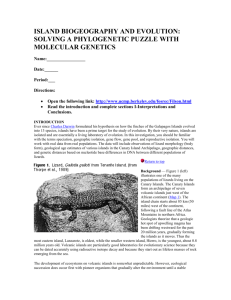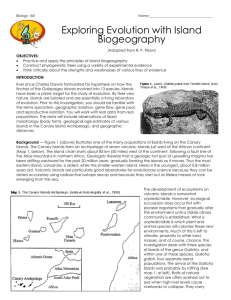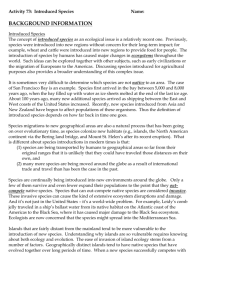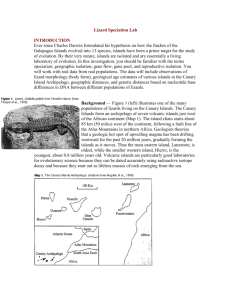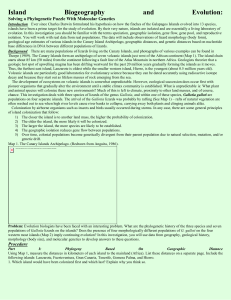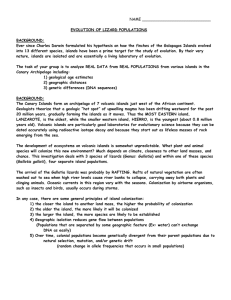island biogeography and evolution: solving a phylogenetic puzzle
advertisement
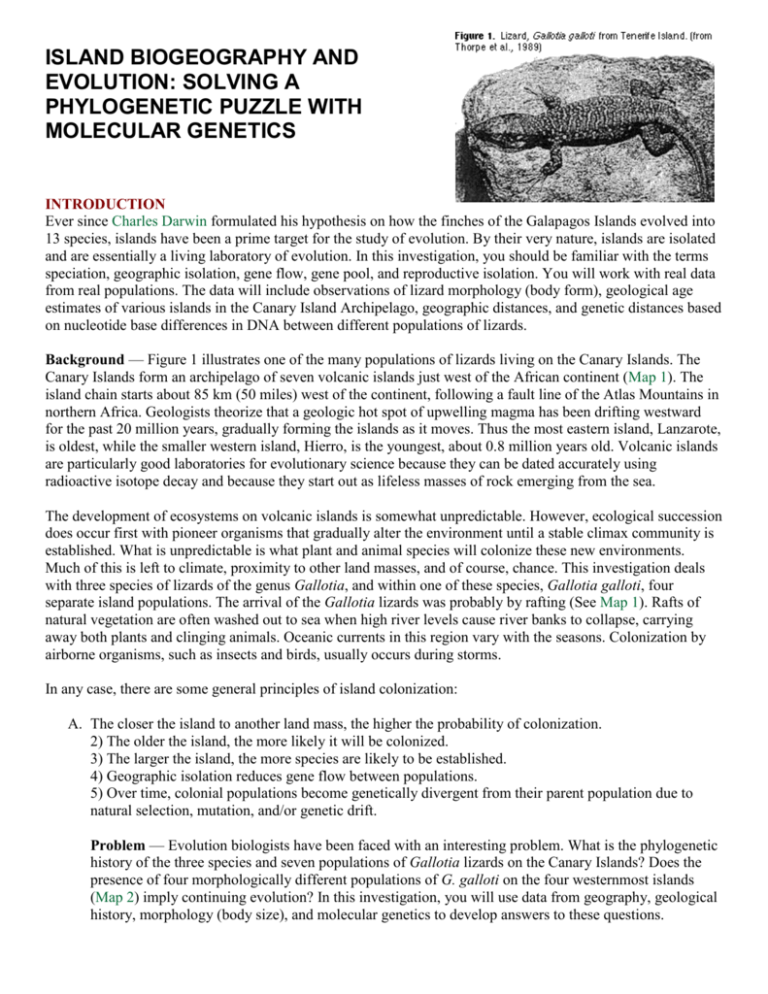
ISLAND BIOGEOGRAPHY AND EVOLUTION: SOLVING A PHYLOGENETIC PUZZLE WITH MOLECULAR GENETICS INTRODUCTION Ever since Charles Darwin formulated his hypothesis on how the finches of the Galapagos Islands evolved into 13 species, islands have been a prime target for the study of evolution. By their very nature, islands are isolated and are essentially a living laboratory of evolution. In this investigation, you should be familiar with the terms speciation, geographic isolation, gene flow, gene pool, and reproductive isolation. You will work with real data from real populations. The data will include observations of lizard morphology (body form), geological age estimates of various islands in the Canary Island Archipelago, geographic distances, and genetic distances based on nucleotide base differences in DNA between different populations of lizards. Background — Figure 1 illustrates one of the many populations of lizards living on the Canary Islands. The Canary Islands form an archipelago of seven volcanic islands just west of the African continent (Map 1). The island chain starts about 85 km (50 miles) west of the continent, following a fault line of the Atlas Mountains in northern Africa. Geologists theorize that a geologic hot spot of upwelling magma has been drifting westward for the past 20 million years, gradually forming the islands as it moves. Thus the most eastern island, Lanzarote, is oldest, while the smaller western island, Hierro, is the youngest, about 0.8 million years old. Volcanic islands are particularly good laboratories for evolutionary science because they can be dated accurately using radioactive isotope decay and because they start out as lifeless masses of rock emerging from the sea. The development of ecosystems on volcanic islands is somewhat unpredictable. However, ecological succession does occur first with pioneer organisms that gradually alter the environment until a stable climax community is established. What is unpredictable is what plant and animal species will colonize these new environments. Much of this is left to climate, proximity to other land masses, and of course, chance. This investigation deals with three species of lizards of the genus Gallotia, and within one of these species, Gallotia galloti, four separate island populations. The arrival of the Gallotia lizards was probably by rafting (See Map 1). Rafts of natural vegetation are often washed out to sea when high river levels cause river banks to collapse, carrying away both plants and clinging animals. Oceanic currents in this region vary with the seasons. Colonization by airborne organisms, such as insects and birds, usually occurs during storms. In any case, there are some general principles of island colonization: A. The closer the island to another land mass, the higher the probability of colonization. 2) The older the island, the more likely it will be colonized. 3) The larger the island, the more species are likely to be established. 4) Geographic isolation reduces gene flow between populations. 5) Over time, colonial populations become genetically divergent from their parent population due to natural selection, mutation, and/or genetic drift. Problem — Evolution biologists have been faced with an interesting problem. What is the phylogenetic history of the three species and seven populations of Gallotia lizards on the Canary Islands? Does the presence of four morphologically different populations of G. galloti on the four westernmost islands (Map 2) imply continuing evolution? In this investigation, you will use data from geography, geological history, morphology (body size), and molecular genetics to develop answers to these questions. PART I: PHYLOGENY BASED ON GEOGRAPHICAL DISTANCE Using Map 1, measure the distance in kilometers of each island to the mainland (Africa). List these distances on your answer sheet. Include the following islands: Lanzarote, Fuerteventura, Gran Canaria, Tenerife, Gomera, Palma, and Hierro. 1) Which island is most likely to have been colonized first and which last? Tell why you think so. Using Map 2 and your geographic reasoning, draw on a separate page a hypothetical phylogenetic (family) tree of the three species and the three additional populations of G. galloti.. Label your end branches with the following population names: atlantica stehlini galloti Tenerife galloti Palma galloti Gomera galloti Hierro PART II: PHYLOGENY BASED ON GEOLOGICAL HISTORY Check your hypothetical phylogenetic tree against the geological data in Table 1. The maximum age of each island was estimated by sampling volcanic rocks found on all islands. The ratio of radioactive potassium to its breakdown product, argon, was used to estimate the age of the rocks. 2) Explain how the data in Table 1 support your phylogeny diagram? Or what changes should you make and why? PART III: PHYLOGENY BASED ON MORPHOLOGY Study the drawings from each lizard population in Figure 2. Compare and contrast their body size with the distribution on Map 2. To be sure differences were genetic, not environmental, researchers collected individuals from all island populations and bred and raised them in captivity. Their offspring still displayed differences according to their parental characteristics. Draw a new phylogeny chart based on morphological similarities and differences. 3) Compare your two phylogeny charts. Describe how they are different. PART IV: PHYLOGENY BASED ON MOLECULAR GENETICS Recent studies by R.S. Thorpe (1993, 1994) have attempted to support various phylogenetic hypotheses by comparing genetic differences among the populations of the Gallotia lizards on the Canary Islands. The gene for cytochrome b, which is coded by DNA found in every cell’s mitochondria, was used in this study along with DNA from other genes. Cytochrome b is an important substance for cell metabolism and has probably been around since the first prokaryotes. Changes in its nucleotide base sequence (A, T, C, and G) that do not disrupt the gene’s function provide us with a kind of evolutionary clock. The rate of mutational changes due to pairing errors is relatively constant. The chances for such mutations are the same for any of these bases. This means that the more time, the more changes. When two populations are isolated and gene flow between them is restricted, the mutational differences accumulate over time. The longer the isolation the greater the difference. Thorpe and his colleagues used restriction enzymes to cut the DNA, and gel electrophoresis to separate the fragments. Radioisotope tagging eventually led to the sequencing of the samples of DNA for each of the seven populations. Thorpe tested two populations on Tenerife to see if ecological differences were part of the story. He felt that because Tenerife is moist and lush in the north while arid and barren in the south, populations on that island might have some genetic differences. Also, he wondered if Tenerife was supplying colonizing lizards from two different directions. The results for Thorpe’s tests appear on the last two pages of this investigation. Your task is to count the differences between all pairings of the seven populations and use that data to construct a final phylogenetic tree based on genetic similarities and differences. Procedure — There are 21 different pair combinations possible using seven populations. You should work in a team of four. Each person will be responsible for counting all of the base differences for five of the 21 pairs (see chart below). Note that the first pairing has been counted for you. Record your results in Table 2. When all teams are done, the data will be checked for agreement. The easiest way to make accurate counts is to cut the paper into four strips and tape them end to end in the correct order, A to D. You will then compare pairs of strips side by side to count the differences. There are 21 possible pairings, each team member selects five pairings other than 1/2. Student #1 Student #2 Student #3 Student #4 1/3 1/4 1/5 1/6 1/7 2/3 2/4 2/5 2/6 2/7 3/4 3/5 3/6 3/7 4/5 4/6 4/7 5/6 5/7 6/7 INTERPRETATIONS AND CONCLUSIONS Use the data from Table 2 to guide you in redrawing your phylogenetic tree of the Gallotia lizards of the Canary Islands using both geographic and genetic information. Consider the two populations on Tenerife as a single population so that the phylogenetic tree contains six populations. Low numbers express more genetic similarity and imply more recent common ancestry. Pairs with high numbers are said to have greater genetic distance between them. In other words, large numbers imply they are less genetically alike, have more distant ancestry, and have been separated longer. On a phylogenetic tree, early ancestry is expressed by low branches while more recently evolved are on the higher branches. Branches that are far apart imply greater genetic distance. ANALYSIS: 4) In Table 2, large numbers imply that pairs of populations are less related. Why is this? 5) Among the six populations, there are three species. How many base pair differences is the minimum to separate any two species of these lizards? (Remember, don’t confuse populations with species.) Give an example to support your answer. 6) Which two populations are most closely related? Justify your answer. 7) Why should you expect the populations S. Tenerife (ST) and N. Tenerife (NT) to have fewer differences than other pairings? 8) Which population is least related to the rest? Why do you say so? Refer to your last phylogeny chart using genetic similarities and differences found in Table 2. Compare it to the phylogeny chart you drew based on the geographic distances and geologic age of the islands. 9) What difference is there between the two phylogenies? 10) Which species, G. stehlini or G. atlantica, is the ancestor of the other? Explain your reasoning. 11) Predict what is likely to happen to the four populations of G. galloti on the four westernmost islands. State what conditions will support this prediction.
